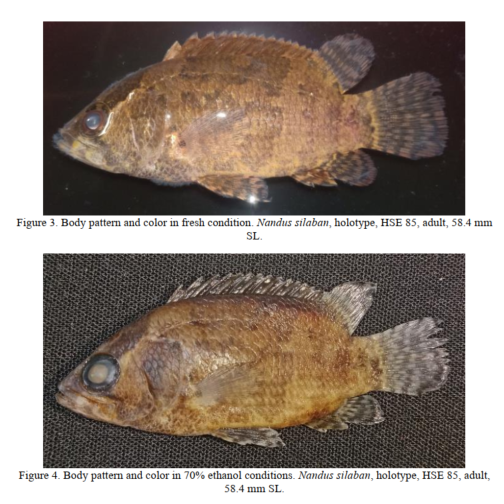Discovery of a New Species: Nandus silaban, a Leaf Fish Native to the Dumai River
The Jin River has given another precious gift. Now, it is our turn to keep the story of Nandus silaban from ending like Arcusconcavum romantii.
Discovery of a New Species: Nandus silaban, a Leaf Fish Native to the Dumai River
Dumai, Riau – June 2025
Hasiholan Science Explorer (HSE), a multidisciplinary research community in Dumai, officially announced the discovery of a new fish species called Nandus silaban. This species was found in the Jin River, a tributary of the Dumai River, and has unique characteristics that distinguish it from all other members of the Nandus genus.
The three young researchers involved in this discovery are Rachel Arini Partogi Hasiholan-Sidauruk (18), Rika Sari Hasiholan-Sidauruk (20), and Anggie Hasiholan Sidauruk (16). This research is part of the Dumai Biodiversity Research Project which has been carried out since 2023.


Nandus silaban as stated in the preprint. Source: https://www.researchgate.net/publication/392967019_Nandus_silaban_Teleostei_Nandidae_a_new_leaf_fish_found_in_the_Jin_River_a_tributary_of_the_Dumai_River_Sumatra
Scientific Characteristics of Nandus silaban
This fish has a distinctive morphology, including:
The largest number of pectoral fin rays in its genus (18),
Large eye size (up to 33.6% of head length in juveniles),
Shorter snout length compared to other species,
The discovery of unique structures in the form of cavus and poris, which are sensory organs with shapes and positions that have never been recorded in the Nandus genus before.
This fish specimen has been preserved and some were sent to the Zoologicum Bogoriense Museum and Riau University for further registration and documentation purposes.
Learning from Arcusconcavum romantii
Previously, the same team also discovered a new catfish species called Arcusconcavum romantii in 2024. However, due to environmental damage at the location of the discovery, the specimen could not be found again. Until now, the re-search process is still ongoing, without results.
This incident became an important basis for why the research team submitted an official request to the Dumai City Government so that the discovery of Nandus silaban could be presented formally to officials and related agencies.
"We hope that the experience of losing the Arcusconcavum romantii specimen will not be repeated. This discovery should be a trigger for the protection of biodiversity in Dumai," said Arif Budiman, the project's Publication Manager.
Conservation Direction
The research team said that the aquatic biodiversity in Dumai has great potential, but is currently facing great pressure due to environmental degradation such as pollution, land conversion, and the use of chemical fertilizers in the area around the river.
The preprint research document has been published via ResearchGate with the title:
Contact and Follow-up
For further coordination, interested communities and agencies can contact:
Arif Budiman, Publication Manager – email: arif@hasiholan.org
Rachel Arini, Team Leader – email: rachel@hasiholan.org
Innovation and Research Institute for Regional Potency
Lembaga Inovasi dan Kajian Potensi Daerah
Partnership
CONTACT US
humas@likpd.org
© 2024. All rights reserved.


